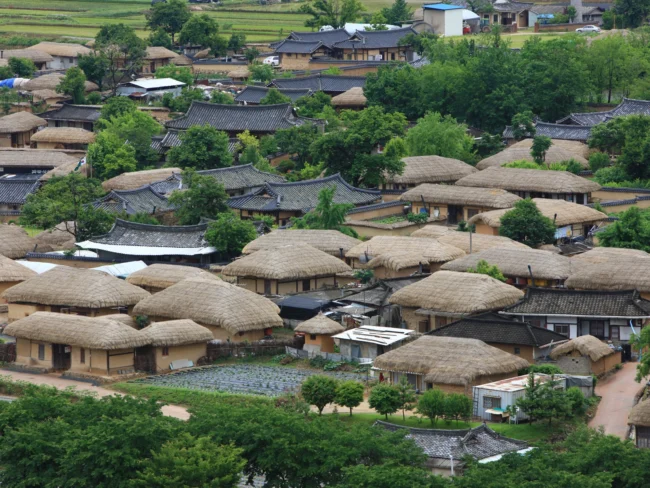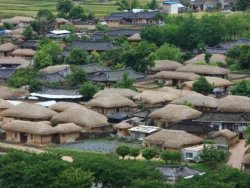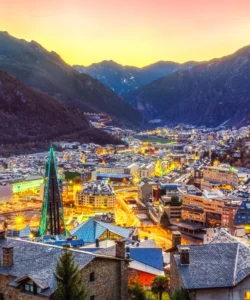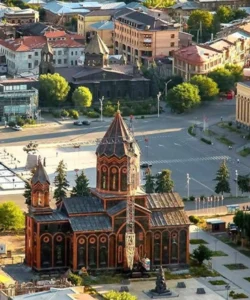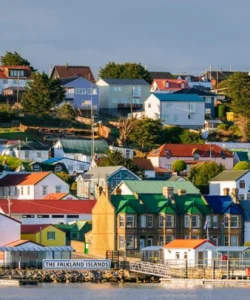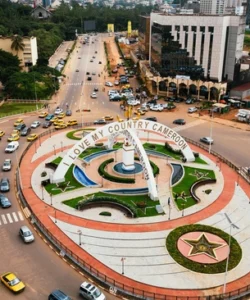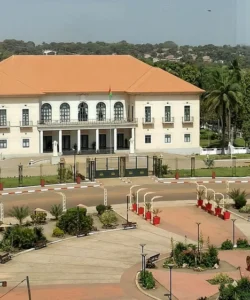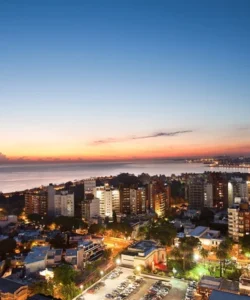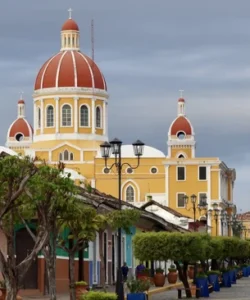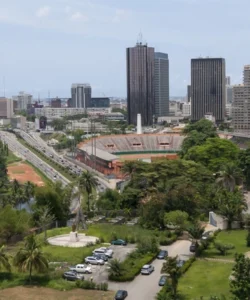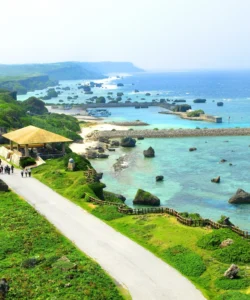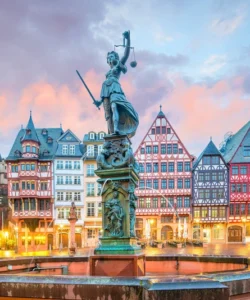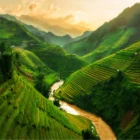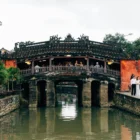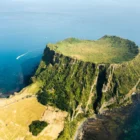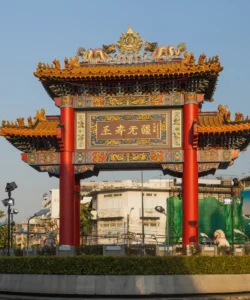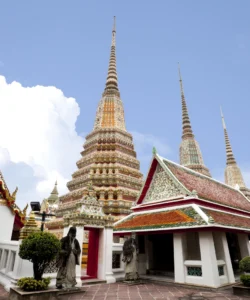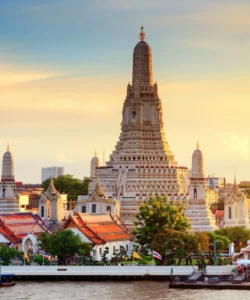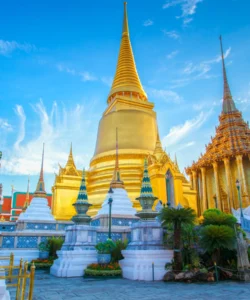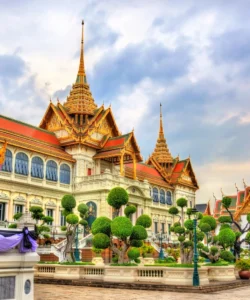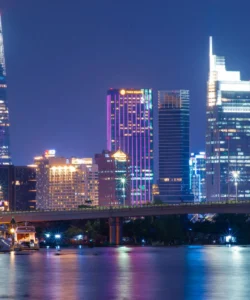Hahoe Folk Village is an extraordinary traditional Korean village located near the city of Andong, in Gyeongsangbuk-do Province, South Korea. It is a UNESCO World Heritage site and a living, functioning clan village that has been continuously inhabited by the descendants of the Ryu clan of Pungsan for over 600 years. Its unique layout, deeply influenced by feng shui (pungsu-jiri-seol), and its well-preserved Joseon-era architecture offer a rare and authentic glimpse into Korea’s Confucian past.
Name: Hahoe Folk Village (하회마을; 河回마을). The name “Hahoe” means “the place where the water turns around,” referring to the Nakdong River that elegantly wraps around the village in an S-shape.
Address: 186 Jeonseo-ro, Pungcheon-myeon, Andong-si, Gyeongsangbuk-do, South Korea.
How to get there:
Reaching Hahoe Folk Village typically involves getting to Andong first, then taking local transport:
- From Seoul to Andong:
- By Bus: Buses depart frequently from Dong Seoul (East) Bus Terminal or Express Bus Terminal in Seoul to Andong. The journey takes approximately 3 hours.
- By Train: KTX trains and other train services connect Seoul to Andong Station.
- From Andong to Hahoe Folk Village:
- Local Bus (Bus 246 or 210): From Andong Bus Terminal or Andong Station, take local bus number 246 or 210 directly to Hahoe Folk Village. The bus ride takes about 50-60 minutes. There’s a free shuttle bus from the main car park to the village entrance.
- Taxi: A taxi from Andong to Hahoe takes about 30-50 minutes.
- Organized Tour: Many tour operators offer day trips or multi-day tours from major cities like Seoul or Busan that include Hahoe Folk Village.
Landscape and Architecture:
The landscape and architecture of Hahoe Folk Village are a harmonious blend of natural beauty and human design, reflecting profound philosophical principles:
- Riverine Setting (Hahoe’s Signature): The most striking natural feature is the Nakdong River, which makes a significant turn, almost encircling the village. This geographical feature gives the village its name and is central to its auspicious feng shui (pungsu-jiri-seol) layout, often compared to a lotus flower or two intertwined comma shapes.
- Buyongdae Cliff: Across the Nakdong River to the north, the majestic Buyongdae Cliff offers a panoramic viewpoint from which to admire the village’s unique layout and the surrounding natural beauty. It’s accessible by a small ferry (seasonal) or a walking path.
- Traditional Hanok Houses: The village is an exceptional collection of traditional Korean houses (hanoks) from the Joseon Dynasty. These houses are categorized by their former inhabitants:
- Yangban (Noblemen’s) Houses: Larger, more elaborate tile-roofed houses (giwa집) with distinct male (sarangchae) and female (anchae) living quarters, often featuring private courtyards and dedicated shrines. Examples include Yangjindang Residence and Chunghyodang Residence.
- Commoners’ Houses: Simpler, often thatched-roofed houses (choga집), reflecting the daily life of common people. This mix of noble and commoner residences within one village is a significant aspect of Hahoe.
- “Lotus Flower” Layout: The village’s overall layout is said to resemble a lotus flower, with the village at its center and surrounding mountains (Namsan to the south, Buyongdae Cliff to the north) and the river forming its petals.
- Traditional Streets and Alleys: The village features unpaved paths and narrow, winding alleys that invite leisurely exploration, preserving the feel of a centuries-old community.
- Samsindang Tree and Shrine: A sacred zelkova tree (over 600 years old) with a shrine next to it. Unlike many traditional Korean homes that face south, some houses in Hahoe face this sacred tree, indicating its importance in village rituals.
- Confucian Academies and Pavilions: Nearby, sites like the Byeongsanseowon Confucian Academy (also a UNESCO site) and numerous pavilions built for scholarly pursuits and contemplation, further emphasize the deep Confucian influence on the village.
What makes it famous:
Hahoe Folk Village is famous for:
- UNESCO World Heritage Site: Inscribed in 2010 (along with Yangdong Folk Village), it’s recognized for its outstanding universal value in preserving the architectural styles, social structure, and living traditions of the Joseon Dynasty.
- Authentic Living Village: Unlike many “folk villages” that are reconstructed or museum-like, Hahoe is a still-inhabited village, with descendants of the Ryu clan (who founded the village) still making up a significant portion of its residents. This provides a genuine, living cultural experience.
- Unique Geographical Layout and Feng Shui: Its distinctive “river-enveloped” (Hahoe) setting and its adherence to feng shui principles in its layout are highly renowned and visually striking.
- Hahoe Mask Dance Drama (Hahoe Byeolsingut Tallori): The village is the origin and home of this traditional, satirical mask dance drama, which is a significant intangible cultural heritage. Performances are often held for visitors, especially during the annual Andong Mask Dance Festival in October. The Hahoe Masks themselves are iconic and made from alder wood, unlike most Korean masks that are made from gourds and discarded after one use.
- Preservation of Joseon-era Social Structure: The village provides a vivid example of a traditional clan village, showcasing the hierarchical social structure of Joseon society, with distinct residences for the yangban (nobility) and commoners.
- Connection to Prominent Scholars: It is the birthplace of many notable Confucian scholars, most famously Ryu Seong-ryong (1542-1607), a prominent Prime Minister during the Joseon Dynasty. His residence, Chunghyodang, is one of the important houses open to the public.
Differences from some other wonders:
Hahoe Folk Village distinguishes itself from other traditional villages and historical sites in several key ways:
- Clan Village (Dongseong Chon): While Bukchon Hanok Village in Seoul is also a residential hanok area, Hahoe is specifically a clan village, where a single lineage (the Pungsan Ryu clan) has continuously resided for centuries. This strong familial and ancestral connection makes it a unique sociological and cultural phenomenon.
- Geographical and Feng Shui Harmony: Its iconic riverine setting and the meticulous application of feng shui principles in its overall layout are more pronounced and central to its identity than in many other traditional villages. The village is literally shaped by its relationship with water and mountains.
- Mix of Noble and Commoner Houses: Unlike some villages that might primarily showcase one social class, Hahoe features a diverse collection of both grand tile-roofed noblemen’s houses and simpler thatched-roofed commoners’ houses, providing a comprehensive picture of Joseon-era residential architecture and social hierarchy within one locale.
- Home of a Specific Mask Dance Tradition: Its origin as the home of the Hahoe Mask Dance Drama and the unique Hahoe masks (made of wood, unlike most temporary Korean masks) gives it a specific artistic and ritualistic heritage that is integral to its identity.
- Rural, Immersive Experience: While Bukchon is integrated into a modern metropolis, Hahoe is situated in a more rural, tranquil setting, offering a deeper sense of immersion in a traditional, agrarian way of life, away from the urban bustle.
In essence, Hahoe Folk Village is a profound and living heritage site, offering an unparalleled journey into the heart of Joseon Dynasty culture, its architectural beauty, its enduring traditions, and the harmonious relationship between man and nature, all sustained by a vibrant, continuing clan community.
